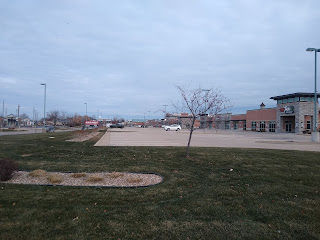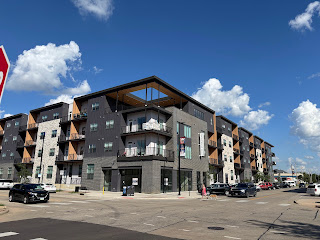Regulations concerning parking comprise 25 pages of the Cedar Rapids municipal code. They are "intended to ensure that adequate parking is provided to meet the needs of individual site designs and the community at-large" (32.04.02.A.1); later the same section refers to "appropriate" amounts of parking. These terms represent value judgments, in spite of the calculations suggested in 32.04.02.B and other attempts at objectivity. They seem to say "You be you, and we'll figure out the parking," but that assumes everyone makes free choices, and those free choices result in the best possible city design. I'd argue both of those assumptions.
The section contains numerous tables defining minimum parking requirements for a given development. General parking requirements (Table 32.04.02-3, pp. 132-134) include two per residential dwelling unit, with less for buildings with small apartments and accessory dwelling units; live-work units are required to have an additional parking space for every 333 square feet of office space. Cemeteries are required to have one parking space for every 50 square feet of the chapel. Elementary and middle schools are required to have two parking spaces per classroom, while high schools are required to have six per classroom plus one per 300 square feet of non-classroom floor space. Want to teach ballet? Studios and instructional spaces are required to have one per 333 square feet. Financial institutions are required to have one per 200 square feet used by the general public, plus one per 600 square feet not used by the general public. This is a fascinatingly granular table, and the effort to compile it must have been impressive.
More importantly, Cedar Rapids now--and I'm pretty sure this is a recent development--has maximum parking rules, as well as exemptions and exceptions to parking minima. Maxima are determined as a percentage of minima (Table 32.04.02-5, p. 135): if 0-49 spaces are required based on Table 32.04.02-3, for example, developments can have no more than the greater of 6 spaces or 150 percent of the minimum number required. Section 32.04.02.F allows exceptions for downtown, and reduced minima for shared parking spaces, residences for the elderly or handicapped, closeness to a bus stop, and connection by sidewalk to trails.
At the very least, this shows sensitivity to the way parking lots waste urban space, and a willingness to develop at least the core part of the city in a way that can serve multiple functions besides car storage. I do not, however, think that Cedar Rapids parking craters are caused by municipal regulation. I think they're caused by the way we do things, at least most of us most of the time, with the ability to ignore people who must or want to do things in a different way. For example, the Blairs Ferry Road Target, in whose parking lot I took three pictures the very first year I did #BlackFridayParking, has 173,941 square feet of retail space, which indicates a minimum of 523 spaces. Maybe I'll count them next year? I'm pretty sure they have a lot more, and were never sweating that zoning regulation back in 2002.
There may be, somewhere in the Cedar Rapids municipal code, an ordinance requiring me to have a second helping of stuffing at Thanksgiving dinner. All that stuffing has analogous negative effects on my physical health to the effects of all that parking on our towns' civic, environmental, and financial health. (Also, by discouraging walking and cycling, too much parking makes us less healthy, just like too much stuffing!) But I'm not stuffing in the stuffing because I'm concerned about an ordinance. I'm doing it because it's what I do on Thanksgiving. Similarly, we build commercial property with gigantic parking lots because that's just what's done.
You be you, drive to Target or Wal-Mart or Fleet Farm, and we'll make sure there's a space for you to park your car. But all this parking is not a neutral engineering/planning response to what people happen to do. It is part of a chain of fateful choices by powerful people that cause the town to develop in a way that driving is what everyone must do.
Fleet Farm, 4650 Cross Pointe Blvd built 2019 189,595 sqft store on 832,867 sq ft lot required parking spaces 570 actual ??
 |
| NE edge of the lot |
 |
| SE edge of the lot |
Fleet Farm is a new big-box kid in town. I remember when Chuck Marohn referenced them in his 2015 speech at Iowa City, and multiple people including me corrected him to "Farm and Fleet." We are all aware of Fleet Farm now! There were a lot of shoppers at Fleet Farm this morning, in search of deals like these...
...and they came in a lot of cars, but there was room for plenty more!
Hy-Vee, 5050 Edgewood Rd built 2005 87,524 sqft store on 494,842 sqft lot required parking spaces 263 actual ??
 |
| west edge of the lot |
 |
| It's quite the strip |
 |
| Another lot of parking |
 |
| People in this subdivision could walk to Jimmy John's, or Hy-Vee! |
Wal-Mart, 2645 Blairs Ferry Rd built 1990 204,266 sqft store on 772,783 sqft lot required parking spaces 614 actual ??
 |
| Lowe's is west of Wal-Mart |
 |
| NW look at Wal-Mart |
 |
| Sam's Club is east of Wal-Mart |
 |
| "You could build a small town in that parking lot"-- awed Twitter comment |
I did not take pictures of the closer-in sections of the parking lots, so it behooves me to tell you there were a lot of shoppers at all of these stores... just not nearly enough to fill the parking lots. Gigantism of stores and parking lots are a bill of goods sold on convenience and ease of access. It's time to pay attention to what they do to our town's social fabric, fiscal health, &c.
 |
| Dunkin' Donuts: I don't understand my fellow humans (Similar scenes at McDonald's and Starbucks) |
SEE ALSO
"I Wish This Parking Was...," 27 November 2020 [last year's COVID lockdown-appropriate alternative]
"Black Friday Parking," 27 November 2015 [my first venture]
Associated Press, "Holiday Shopping Moves Into High Gear But Challenges Remain," KTLA, 25 November 2021
City of Cedar Rapids, Zoning Ordinance, 14 March 2021 [Section 32.04.02, "Parking," is on pp. 129-154]
Charles Marohn,"Where Parking Reform Ideas Go to Die... or Not," Strong Towns, 24 November 2021 [a story with a happy ending!]
Strong Towns, "Where Will You Be on #BlackFridayParking Day?" 22 November 2021 [this year's invitation]
 |
| Black Friday shopping can be a real battle? |
 |
| I'm enjoying this way too much |











